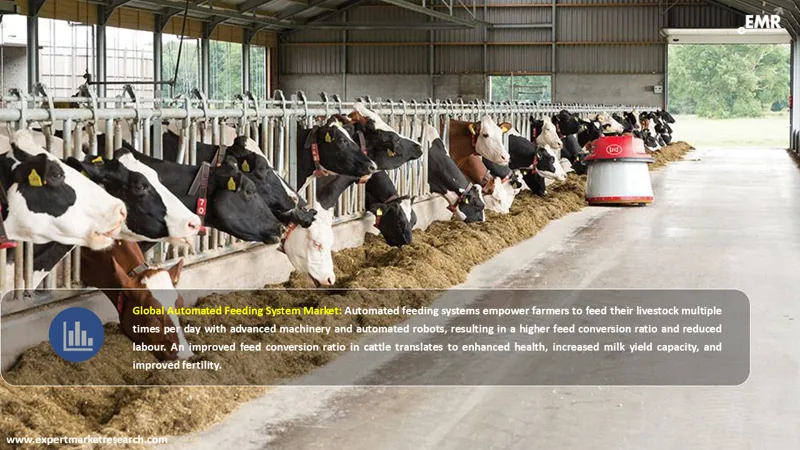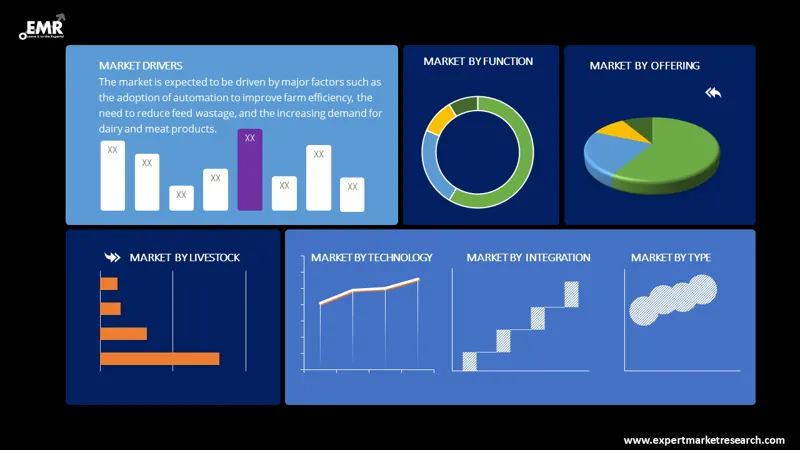
Consumer Insights
Uncover trends and behaviors shaping consumer choices today
Procurement Insights
Optimize your sourcing strategy with key market data
Industry Stats
Stay ahead with the latest trends and market analysis.
The global automated feeding system market size is expected to grow at a CAGR of 7.30% in the forecast period of 2026-2035, reaching a value of around USD 15.47 Billion by 2035. The market is being driven by the expansion of dairy farms and rising investments towards smart livestock farming technologies.
Base Year
Historical Period
Forecast Period
Compound Annual Growth Rate
7.3%
2026-2035
*this image is indicative*
Automated feeding systems refer to a type of system in which the organisation, allocation, and dispensation of feed resources are carried out using automated mechanisms. An automated feeding system consists of a control unit which provides electrical power supply to the mechanism leading to a precise start and stop feed distribution process. Automated feeding systems simplify the process of feeding large numbers of livestock simultaneously.

Read more about this report - REQUEST FREE SAMPLE COPY IN PDF
The EMR’s report titled “Automated Feeding System Market Report and Forecast 2026-2035 offers a detailed analysis of the market based on the following segments:
Market Breakup by Function
Market Breakup by Type
Market Breakup by Offering
Market Breakup by Livestock
Market Breakup by Technology
Market Breakup by Integration
Market Breakup by Region

Read more about this report - REQUEST FREE SAMPLE COPY IN PDF
The conveyor feeding systems segment, based on type, accounts for a healthy share of the automated feeding system market. Conveyor systems are a superior material handling and feeding equipment which speed up the transportation of foods, cuts down the need of human labour, and minimises manual handling. In addition, these systems can enhance efficiency of feeding, while ensuring proper maintenance of the quality standards which is fuelling the growth of this segment. With numerous types of conveyor feeding systems available, livestock farmers can choose options that suit their operation size and objectives.
At a regional level, Europe accounts for a significant share of the global automated feeding system market. Increasing demand for poultry, dairy, and meat products coupled with relatively high labour costs are leading to increased adoption of technology for livestock farming. More livestock farmers in the region are investing in automated feeding systems to adequately meet the nutritional requirements of their animals with reduced need for manpower. Increasing number of dairy farms in the region, presence of key market players, and the substantial cost savings that automated feeding systems can offer are expanding the opportunities for the automated feeding system market.
The comprehensive EMR report provides an in-depth assessment of the market based on the Porter's five forces model along with giving a SWOT analysis. The report gives a detailed analysis of the key players in the global automated feeding system market, covering their competitive landscape and latest developments like mergers, acquisitions, investments and expansion plans.
AGCO Corporation is a leading agricultural machinery company which designs, produces, and sells tractors, foragers, hay tools, and self-propelled sprayers, among other smart farming technologies. Founded in 1990, the company is headquartered in Georgia, United States.
Trioliet B.V. is a renowned family-owned company which specialises in the development, production, and marketing of feeding machines and livestock farming systems. The company was established in 1950 and is currently headquartered in Oldenzaal in the Netherlands.
Pellon Group Oy is a leading company which offers a wide range of solutions for milk, beef, and pork production to improve farm productivity. The establishment of this company took place in 1966 and is headquartered in Southern Ostrobothnia, Finland.
*Please note that this is only a partial list; the complete list of key players is available in the full report. Additionally, the list of key players can be customized to better suit your needs.*
Other market players include GEA Group Aktiengesellschaft, Rovibec Agrisolutions, Roxell BV, VDL Agrotech bv, and Lely International N.V., among others.




*While we strive to always give you current and accurate information, the numbers depicted on the website are indicative and may differ from the actual numbers in the main report. At Expert Market Research, we aim to bring you the latest insights and trends in the market. Using our analyses and forecasts, stakeholders can understand the market dynamics, navigate challenges, and capitalize on opportunities to make data-driven strategic decisions.*
Get in touch with us for a customized solution tailored to your unique requirements and save upto 35%!
The market is estimated to grow at a CAGR of 7.30% between 2026 and 2035.
The market is estimated to witness a healthy growth in the forecast period of 2026-2035, reaching a value of around USD 15.47 Billion by 2035.
The major drivers of the market include heightening application of automated feeding systems across dairy farms, rising demand for animal-based products, and growing awareness pertaining to the advantages of automated feeding systems.
The key trends of the market include the increasing adoption of cloud-based software in automated feeding systems, rising investments by farms owners towards smart farming technologies, technological advancements in automated feeding systems, and rising costs of human labour across emerging economies.
The different functions of automated feeding systems in the market are controlling, mixing, and filling and screening, among others.
The various livestock in the market for automated feeding systems are poultry, swine, ruminants, and equine, among others.
The major market players, according to the report, are AGCO Corporation, Trioliet B.V., Pellon Group Oy, GEA Group Aktiengesellschaft, Rovibec Agrisolutions, Roxell BV, VDL Agrotech bv, and Lely International N.V., among others.
Explore our key highlights of the report and gain a concise overview of key findings, trends, and actionable insights that will empower your strategic decisions.
| REPORT FEATURES | DETAILS |
| Base Year | 2025 |
| Historical Period | 2019-2025 |
| Forecast Period | 2026-2035 |
| Scope of the Report |
Historical and Forecast Trends, Industry Drivers and Constraints, Historical and Forecast Market Analysis by Segment:
|
| Breakup by Function |
|
| Breakup by Type |
|
| Breakup by Offering |
|
| Breakup by Livestock |
|
| Breakup by Technology |
|
| Breakup by Integration |
|
| Breakup by Region |
|
| Market Dynamics |
|
| Competitive Landscape |
|
| Companies Covered |
|
| Report Price and Purchase Option | Explore our purchase options that are best suited to your resources and industry needs. |
| Delivery Format | Delivered as an attached PDF and Excel through email, with an option of receiving an editable PPT, according to the purchase option. |
Datasheet
One User
USD 2,499
USD 2,249
tax inclusive*
Single User License
One User
USD 3,999
USD 3,599
tax inclusive*
Five User License
Five User
USD 4,999
USD 4,249
tax inclusive*
Corporate License
Unlimited Users
USD 5,999
USD 5,099
tax inclusive*
*Please note that the prices mentioned below are starting prices for each bundle type. Kindly contact our team for further details.*
Flash Bundle
Small Business Bundle
Growth Bundle
Enterprise Bundle
*Please note that the prices mentioned below are starting prices for each bundle type. Kindly contact our team for further details.*
Flash Bundle
Number of Reports: 3
20%
tax inclusive*
Small Business Bundle
Number of Reports: 5
25%
tax inclusive*
Growth Bundle
Number of Reports: 8
30%
tax inclusive*
Enterprise Bundle
Number of Reports: 10
35%
tax inclusive*
How To Order

Select License Type
Choose the right license for your needs and access rights.

Click on ‘Buy Now’
Add the report to your cart with one click and proceed to register.

Select Mode of Payment
Choose a payment option for a secure checkout. You will be redirected accordingly.
Gain insights to stay ahead and seize opportunities.

Get insights & trends for a competitive edge.

Track prices with detailed trend reports.

Analyse trade data for supply chain insights.

Leverage cost reports for smart savings

Enhance supply chain with partnerships.

Connect For More Information
Our expert team of analysts will offer full support and resolve any queries regarding the report, before and after the purchase.
Our expert team of analysts will offer full support and resolve any queries regarding the report, before and after the purchase.
We employ meticulous research methods, blending advanced analytics and expert insights to deliver accurate, actionable industry intelligence, staying ahead of competitors.
Our skilled analysts offer unparalleled competitive advantage with detailed insights on current and emerging markets, ensuring your strategic edge.
We offer an in-depth yet simplified presentation of industry insights and analysis to meet your specific requirements effectively.
Share